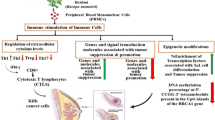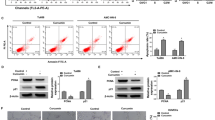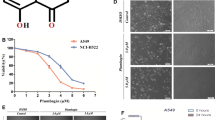Abstract
Previous studies have demonstrated that the persistent exposure of human bronchial epithelial cells to nicotine (Nic) through nicotinic acetylcholine receptors increases cyclin D1 promoter activity and protein expression. The main purpose of this study is to elucidate the carcinogenic role of cyclin D3, which is involved in breast tumorigenesis when induced by Nic. Real-time PCR analysis revealed that cyclin D3 is highly expressed at the mRNA level in surgically dissected breast tumor tissue, compared to the surrounding normal tissue (tumor/normal fold ratio = 17.93, n = 74). To test whether Nic/nicotinic acetylcholine receptor (nAChR) binding could affect cyclin D3 expression in human breast cancer cells, the transformed cell line MCF-10A-Nic (DOX) was generated from normal breast epithelial cells (MCF-10A) with inducible α9-nAChR gene expression, using the adenovirus tetracycline-regulated Tet-off system. Tet-regulated overexpression of α9-nAChR in MCF-10A-Nic (DOX) xenografted BALB/c-nu/nu mice resulted in a significant induction of cyclin D3. In contrast, cyclin D3 expression was down-regulated in α9-nAChR knock-down (siRNA) MDA-MB-231-xenografted tumors in NOD.CB17-PRKDC(SCID)/J(NOD-SCID) mice. Furthermore, we found that Nic-induced human breast cancer (MDA-MB-231) cell proliferation was inhibited by 1 μM of garcinol (Gar), isolated from the edible fruit Garcinia indica, through down-regulation of α9-nAChR and cyclin D3 expression. These results suggest that α9-nAChR-mediated cyclin D3 overexpression is important for nicotine-induced transformation of normal human breast epithelial cells. The homeostatic regulation of cyclin D3 has the potential to be a molecular target for antitumor chemotherapeutic or chemopreventive purposes in clinical breast cancer patients.






Similar content being viewed by others
Abbreviations
- AP-1:
-
Activating protein-1
- ChIP:
-
Chromatin immunoprecipitation analysis
- DBM:
-
Dibenzoylmethane
- DMEM:
-
Dulbecco’s modified Eagle’s medium
- DMSO:
-
Dimethylsulfoxide
- DOX:
-
Doxycycline
- FACS:
-
Fluorescence-activated cell sorter
- FAS:
-
Fetal calf serum
- GAPDH:
-
Glyceraldehyde-3-phosphate dehydrogenase
- Gar:
-
Garcinol
- GUS:
-
β-Glucuronidase
- IHC:
-
Immunohistochemistry
- HDB:
-
Dibenzoylmethane1-(2-hydroxyphenyl)-3-phenyl-1,3-propanedione
- HMDB:
-
1-(2-Hydroxy-5-methylphenyl)-3-phenyl-1,3-propanedione
- MTT:
-
3-(4,5-Dimethylthiazol-2-yl)-2,5-diphenyltetrazolium
- NFκB:
-
Nuclear factor kappa B
- Nic:
-
Nicotine
- nAChR:
-
Nicotinic acetylcholine receptor
- NNK:
-
4-(Methylnitrosamino)-1-(3-pyridyl)-1-butanone
- PBS:
-
Phosphate-buffered saline
- RT-PCR:
-
Reverse transcriptase polymerase chain reaction
- siRNA:
-
Small interfering RNA
References
Lin Y, Kikuchi S, Tamakoshi K, Wakai K, Kondo T, Niwa Y, Yatsuya H, Nishio K, Suzuki S, Tokudome S, Yamamoto A, Toyoshima H, Mori M, Tamakoshi A (2008) Active smoking, passive smoking, and breast cancer risk: findings from the Japan Collaborative Cohort Study for Evaluation of Cancer Risk. J Epidemiol 18:77–83
Slattery ML, Curtin K, Giuliano AR, Sweeney C, Baumgartner R, Edwards S, Wolff RK, Baumgartner KB, Byers T (2008) Active and passive smoking, IL6, ESR1, and breast cancer risk. Breast Cancer Res Treat 109:101–111
Armitage AK, Dollery CT, George CF, Houseman TH, Lewis PJ, Turner DM (1975) Absorption and metabolism of nicotine from cigarettes. Br Med J 4:313–316
Benowitz NL, Jacob P III (1984) Nicotine and carbon monoxide intake from high- and low-yield cigarettes. Clin Pharmacol Ther 36:265–270
Lindell G, Farnebo LO, Chen D, Nexo E, Rask Madsen J, Bukhave K, Graffner H (1993) Acute effects of smoking during modified sham feeding in duodenal ulcer patients. An analysis of nicotine, acid secretion, gastrin, catecholamines, epidermal growth factor, prostaglandin E2, and bile acids. Scand J Gastroenterol 28:487–494
Mei J, Hu H, McEntee M, Plummer H III, Song P, Wang HC (2003) Transformation of non-cancerous human breast epithelial cell line MCF10A by the tobacco-specific carcinogen NNK. Breast Cancer Res Treat 79:95–105
Siriwardhana N, Choudhary S, Wang HC (2008) Precancerous model of human breast epithelial cells induced by NNK for prevention. Breast Cancer Res Treat 109:427–441
Heeschen C, Jang JJ, Weis M, Pathak A, Kaji S, Hu RS, Tsao PS, Johnson FL, Cooke JP (2001) Nicotine stimulates angiogenesis and promotes tumor growth and atherosclerosis. Nat Med 7:833–839
Kellar KJ, Davila-Garcia MI, Xiao Y (1999) Pharmacology of neuronal nicotinic acetylcholine receptors: effects of acute and chronic nicotine. Nicotine Tob Res 1(Suppl 2):S117–S120 discussion S139–S140
Brejc K, van Dijk WJ, Klaassen RV, Schuurmans M, van Der Oost J, Smit AB, Sixma TK (2001) Crystal structure of an ACh-binding protein reveals the ligand-binding domain of nicotinic receptors. Nature 411:269–276
Schuller HM, Orloff M (1998) Tobacco-specific carcinogenic nitrosamines. Ligands for nicotinic acetylcholine receptors in human lung cancer cells. Biochem Pharmacol 55:1377–1384
Ho YS, Chen CH, Wang YJ, Pestell RG, Albanese C, Chen RJ, Chang MC, Jeng JH, Lin SY, Liang YC, Tseng H, Lee WS, Lin JK, Chu JS, Chen LC, Lee CH, Tso WL, Lai YC, Wu CH (2005) Tobacco-specific carcinogen 4-(methylnitrosamino)-1-(3-pyridyl)-1-butanone (NNK) induces cell proliferation in normal human bronchial epithelial cells through NFkappaB activation and cyclin D1 up-regulation. Toxicol Appl Pharmacol 205:133–148
Wei PL, Chang YJ, Ho YS, Lee CH, Yang YY, An J, Lin SY (2009) Tobacco-specific carcinogen enhances colon cancer cell migration through alpha7-nicotinic acetylcholine receptor. Ann Surg 249:978–985
Chen RJ, Ho YS, Guo HR, Wang YJ (2008) Rapid activation of Stat3 and ERK1/2 by nicotine modulates cell proliferation in human bladder cancer cells. Toxicol Sci 104:283–293
Troncone G, Volante M, Iaccarino A, Zeppa P, Cozzolino I, Malapelle U, Palmieri EA, Conzo G, Papotti M, Palombini L (2009). Cyclin D1 and D3 overexpression predicts malignant behavior in thyroid fine-needle aspirates suspicious for Hurthle cell neoplasms. Cancer Cytopathol 117:522–529
Maier S, Daroqui MC, Scherer S, Roepcke S, Velcich A, Shenoy SM, Singer RH, Augenlicht LH (2009) Butyrate and vitamin D3 induce transcriptional attenuation at the cyclin D1 locus in colonic carcinoma cells. J Cell Physiol 218:638–642
Joshi I, Minter LM, Telfer J, Demarest RM, Capobianco AJ, Aster JC, Sicinski P, Fauq A, Golde TE, Osborne BA (2009) Notch signaling mediates G1/S cell-cycle progression in T cells via cyclin D3 and its dependent kinases. Blood 113:1689–1698
Zhou Q, Stetler-Stevenson M, Steeg PS (1997) Inhibition of cyclin D expression in human breast carcinoma cells by retinoids in vitro. Oncogene 15:107–115
Chu M, Guo J, Chen CY (2005) Long-term exposure to nicotine, via ras pathway, induces cyclin D1 to stimulate G1 cell cycle transition. J Biol Chem 280:6369–6379
Yu X, Luo Y, Zhou Y, Zhang Q, Wang J, Wei N, Mi M, Zhu J, Wang B, Chang H, Tang Y (2008) BRCA1 overexpression sensitizes cancer cells to lovastatin via regulation of cyclin D1-CDK4–p21WAF1/CIP1 pathway: analyses using a breast cancer cell line and tumoral xenograft model. Int J Oncol 33:555–563
Rudas M, Lehnert M, Huynh A, Jakesz R, Singer C, Lax S, Schippinger W, Dietze O, Greil R, Stiglbauer W, Kwasny W, Grill R, Stierer M, Gnant MF, Filipits M (2008) Cyclin D1 expression in breast cancer patients receiving adjuvant tamoxifen-based therapy. Clin Cancer Res 14:1767–1774
Aaltonen K, Amini RM, Landberg G, Eerola H, Aittomaki K, Heikkila P, Nevanlinna H, Blomqvist C (2009) Cyclin D1 expression is associated with poor prognostic features in estrogen receptor positive breast cancer. Breast Cancer Res Treat 113:75–82
Yamaguchi F, Ariga T, Yoshimura Y, Nakazawa H (2000) Antioxidative and anti-glycation activity of garcinol from Garcinia indica fruit rind. J Agric Food Chem 48:180–185
Yamaguchi F, Saito M, Ariga T, Yoshimura Y, Nakazawa H (2000) Free radical scavenging activity and antiulcer activity of garcinol from Garcinia indica fruit rind. J Agric Food Chem 48:2320–2325
Pan MH, Chang WL, Lin-Shiau SY, Ho CT, Lin JK (2001) Induction of apoptosis by garcinol and curcumin through cytochrome c release and activation of caspases in human leukemia HL-60 cells. J Agric Food Chem 49:1464–1474
Tanaka T, Kohno H, Shimada R, Kagami S, Yamaguchi F, Kataoka S, Ariga T, Murakami A, Koshimizu K, Ohigashi H (2000) Prevention of colonic aberrant crypt foci by dietary feeding of garcinol in male F344 rats. Carcinogenesis 21:1183–1189
Yang CM, Lee IT, Lin CC, Yang YL, Luo SF, Kou YR, Hsiao LD (2009) Cigarette smoke extract induces COX-2 expression via a PKCalpha/c-Src/EGFR, PDGFR/PI3K/Akt/NF-kappaB pathway and p300 in tracheal smooth muscle cells. Am J Physiol Lung Cell Mol Physiol 297:L892–L902
Pan MH, Huang MC, Wang YJ, Lin JK, Lin CH (2003) Induction of apoptosis by hydroxydibenzoylmethane through coordinative modulation of cyclin D3, Bcl-X(L), and Bax, release of cytochrome c, and sequential activation of caspases in human colorectal carcinoma cells. J Agric Food Chem 51:3977–3984
Chen LC, Liu YC, Liang YC, Ho YS and Lee WS (2009) Magnolol inhibits human glioblastoma cell proliferation through upregulation of p21/Cip1. J Agric Food Chem (in press)
Tu SH, Chang CC, Chen CS, Tam KW, Wang YJ, Lee CH, Lin HW, Cheng TC, Huang CS, Chu JS, Shih NY, Chen LC, Leu SJ, Ho YS, Wu CH (2009). Increased expression of enolase alpha in human breast cancer confers tamoxifen resistance in human breast cancer cells. Breast Cancer Res Treat (in press)
West KA, Brognard J, Clark AS, Linnoila IR, Yang X, Swain SM, Harris C, Belinsky S, Dennis PA (2003) Rapid Akt activation by nicotine and a tobacco carcinogen modulates the phenotype of normal human airway epithelial cells. J Clin Invest 111:81–90
Narayan S, Jaiswal AS, Kang D, Srivastava P, Das GM, Gairola CG (2004) Cigarette smoke condensate-induced transformation of normal human breast epithelial cells in vitro. Oncogene 23:5880–5889
Chen F, Kim E, Wang CC, Harrison LE (2005) Ciglitazone-induced p27 gene transcriptional activity is mediated through Sp1 and is negatively regulated by the MAPK signaling pathway. Cell Signal 17:1572–1577
Wilkinson DS, Ogden SK, Stratton SA, Piechan JL, Nguyen TT, Smulian GA, Barton MC (2005) A direct intersection between p53 and transforming growth factor beta pathways targets chromatin modification and transcription repression of the alpha-fetoprotein gene. Mol Cell Biol 25:1200–1212
Govind AP, Vezina P, Green WN (2009) Nicotine-induced upregulation of nicotinic receptors: underlying mechanisms and relevance to nicotine addiction. Biochem Pharmacol 78:756–765
Nuutinen S, Ekokoski E, Lahdensuo E, Tuominen RK (2006) Nicotine-induced upregulation of human neuronal nicotinic alpha7-receptors is potentiated by modulation of cAMP and PKC in SH-EP1-halpha7 cells. Eur J Pharmacol 544:21–30
Al-Wadei HA, Plummer HK 3rd, Schuller HM (2009) Nicotine stimulates pancreatic cancer xenografts by systemic increase in stress neurotransmitters and suppression of the inhibitory neurotransmitter gamma-aminobutyric acid. Carcinogenesis 30:506–511
Ramazzotti G, Faenza I, Gaboardi GC, Piazzi M, Bavelloni A, Fiume R, Manzoli L, Martelli AM, Cocco L (2008) Catalytic activity of nuclear PLC-beta(1) is required for its signalling function during C2C12 differentiation. Cell Signal 20:2013–2021
Elgoyhen AB, Johnson DS, Boulter J, Vetter DE, Heinemann S (1994) Alpha 9: an acetylcholine receptor with novel pharmacological properties expressed in rat cochlear hair cells. Cell 79:705–715
Arredondo J, Chernyavsky AI, Jolkovsky DL, Pinkerton KE, Grando SA (2008) Receptor-mediated tobacco toxicity: acceleration of sequential expression of alpha5 and alpha7 nicotinic receptor subunits in oral keratinocytes exposed to cigarette smoke. FASEB J 22:1356–1368
Noda M, Furutani Y, Takahashi H, Toyosato M, Tanabe T, Shimizu S, Kikyotani S, Kayano T, Hirose T, Inayama S et al (1983) Cloning and sequence analysis of calf cDNA and human genomic DNA encoding alpha-subunit precursor of muscle acetylcholine receptor. Nature 305:818–823
Nef P, Oneyser C, Alliod C, Couturier S, Ballivet M (1988) Genes expressed in the brain define three distinct neuronal nicotinic acetylcholine receptors. EMBO J 7:595–601
Wada K, Ballivet M, Boulter J, Connolly J, Wada E, Deneris ES, Swanson LW, Heinemann S, Patrick J (1988) Functional expression of a new pharmacological subtype of brain nicotinic acetylcholine receptor. Science 240:330–334
Lustig LR (2006) Nicotinic acetylcholine receptor structure and function in the efferent auditory system. Anat Rec A Discov Mol Cell Evol Biol 288:424–434
Nguyen VT, Ndoye A, Grando SA (2000) Novel human alpha9 acetylcholine receptor regulating keratinocyte adhesion is targeted by Pemphigus vulgaris autoimmunity. Am J Pathol 157:1377–1391
Vincler M, Wittenauer S, Parker R, Ellison M, Olivera BM, McIntosh JM (2006) Molecular mechanism for analgesia involving specific antagonism of alpha9alpha10 nicotinic acetylcholine receptors. Proc Natl Acad Sci USA 103:17880–17884
Sgard F, Charpantier E, Bertrand S, Walker N, Caput D, Graham D, Bertrand D, Besnard F (2002) A novel human nicotinic receptor subunit, alpha10, that confers functionality to the alpha9-subunit. Mol Pharmacol 61:150–159
Elgoyhen AB, Vetter DE, Katz E, Rothlin CV, Heinemann SF, Boulter J (2001) alpha10: a determinant of nicotinic cholinergic receptor function in mammalian vestibular and cochlear mechanosensory hair cells. Proc Natl Acad Sci USA 98:3501–3506
Chernyavsky AI, Arredondo J, Vetter DE, Grando SA (2007) Central role of alpha9 acetylcholine receptor in coordinating keratinocyte adhesion and motility at the initiation of epithelialization. Exp Cell Res 313:3542–3555
Arredondo J, Chernyavsky AI, Jolkovsky DL, Pinkerton KE, Grando SA (2007) Receptor-mediated tobacco toxicity: alterations of the NF-kappaB expression and activity downstream of alpha7 nicotinic receptor in oral keratinocytes. Life Sci 80:2191–2194
Song P, Sekhon HS, Fu XW, Maier M, Jia Y, Duan J, Proskosil BJ, Gravett C, Lindstrom J, Mark GP, Saha S, Spindel ER (2008) Activated cholinergic signaling provides a target in squamous cell lung carcinoma. Cancer Res 68:4693–4700
Sato T, Abe T, Nakamoto N, Tomaru Y, Koshikiya N, Nojima J, Kokabu S, Sakata Y, Kobayashi A, Yoda T (2008) Nicotine induces cell proliferation in association with cyclin D1 up-regulation and inhibits cell differentiation in association with p53 regulation in a murine pre-osteoblastic cell line. Biochem Biophys Res Commun 377:126–130
Duan R, Ginsburg E, Vonderhaar BK (2008) Estrogen stimulates transcription from the human prolactin distal promoter through AP1 and estrogen responsive elements in T47D human breast cancer cells. Mol Cell Endocrinol 281:9–18
Cattaneo MG, Codignola A, Vicentini LM, Clementi F, Sher E (1993) Nicotine stimulates a serotonergic autocrine loop in human small-cell lung carcinoma. Cancer Res 53:5566–5568
Seger R, Krebs EG (1995) The MAPK signaling cascade. FASEB J 9:726–735
Guo J, Chu M, Abbeyquaye T, Chen CY (2005) Persistent nicotine treatment potentiates amplification of the dihydrofolate reductase gene in rat lung epithelial cells as a consequence of Ras activation. J Biol Chem 280:30422–30431
Acknowledgment
This study was supported by the National Science Council, Grant NSC 95-2320-B-038-016-MY3 to Dr. Ho and NSC 96-2314-B-038-002 to Dr. Wu, and by the Taipei Medical University Hospital (98TMU-TMUH-02-1) to Dr. Yang.
Author information
Authors and Affiliations
Corresponding authors
Additional information
Chia-Hwa Lee and Chang-Da Hsieh contributed equally to this work.
Electronic supplementary material
Below is the link to the electronic supplementary material.
Rights and permissions
About this article
Cite this article
Chen, CS., Lee, CH., Hsieh, CD. et al. Nicotine-induced human breast cancer cell proliferation attenuated by garcinol through down-regulation of the nicotinic receptor and cyclin D3 proteins. Breast Cancer Res Treat 125, 73–87 (2011). https://doi.org/10.1007/s10549-010-0821-3
Received:
Accepted:
Published:
Issue Date:
DOI: https://doi.org/10.1007/s10549-010-0821-3




